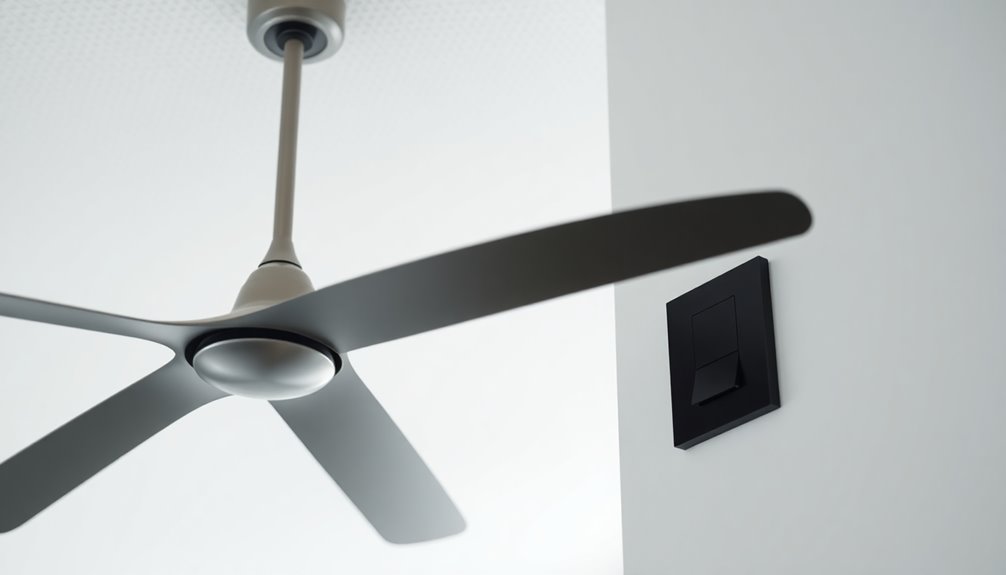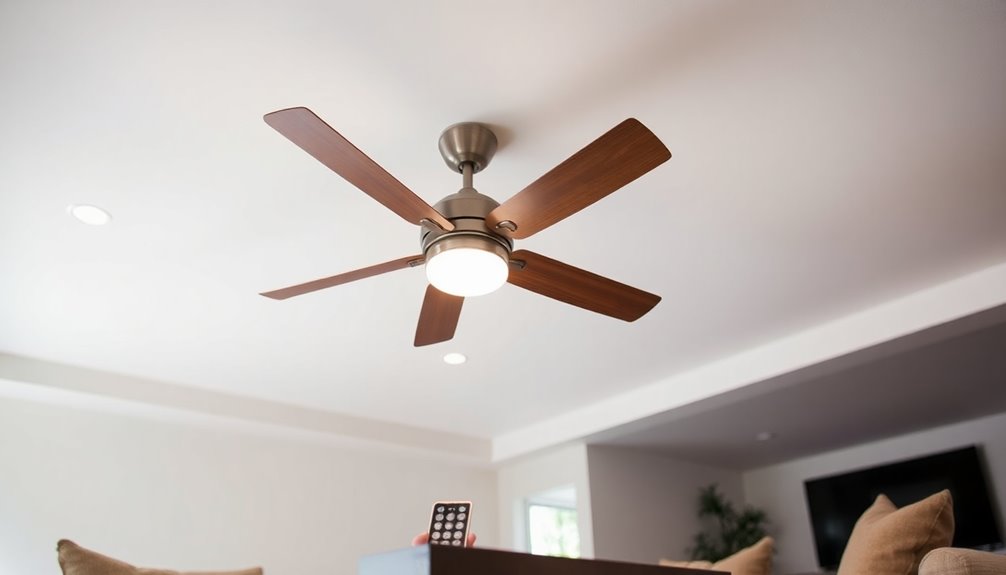The switch on your ceiling fan lets you change the airflow direction to improve comfort and energy efficiency. In summer, you'll want the fan to spin counterclockwise for a cooling breeze. In winter, set it to rotate clockwise to circulate warm air that gathers near the ceiling. This simple adjustment can help you save on energy bills, making your heating and cooling systems work less. Plus, it keeps your home comfortable throughout the year. If you're curious about more tips on using your ceiling fan effectively, you might find it helpful to explore additional details.
Key Takeaways
- The switch on your ceiling fan changes the rotation direction for seasonal airflow adjustments.
- In summer, the switch sets the fan to rotate counterclockwise for a cooling effect.
- In winter, switching to clockwise redistributes warm air trapped at the ceiling, enhancing heating efficiency.
- Proper use of the switch can help save on energy bills by reducing HVAC reliance.
- Regular adjustments with the switch can improve overall home comfort year-round.
Purpose of the Ceiling Fan Switch

The ceiling fan switch serves an essential role in enhancing your comfort at home. By allowing you to change the ceiling fan direction, it helps you adapt to seasonal temperature changes effectively.
In the summer, you can set the fan to rotate counterclockwise, creating a cool breeze that keeps you comfortable. Conversely, in winter, switching the direction to clockwise helps to push warm air down from the ceiling, making your space feel cozier.
Most ceiling fans have a small switch located on the fan's base or remote control, which makes it easy to adjust the airflow as needed. Using this switch not only improves comfort but can also save energy. You can raise your thermostat by up to 4°F without sacrificing warmth, which can lead to substantial savings on your heating bill.
Many people overlook the winter functionality of ceiling fans, but utilizing the switch to create a gentle updraft can redistribute warm air trapped high above. This simple adjustment could potentially lower your heating bills by up to 15%, making it crucial to understand the full purpose of your ceiling fan switch for maximum energy efficiency year-round.
Seasonal Fan Direction Adjustment

Adjusting your ceiling fan's direction is a simple yet effective way to enhance your home's comfort throughout the year. By using the switch on your ceiling fan, you can change the blade direction to suit the season, maximizing both comfort and energy efficiency.
In the summer, set the fan to spin counterclockwise. This creates a downdraft that pushes cool air downward, making your space feel invigoratingly cooler. You'll appreciate the difference, especially on hot days.
As winter rolls around, switch the fan to spin clockwise. This adjustment creates an updraft that helps redistribute warm air trapped near the ceiling, improving the heating efficiency in your home.
Properly adjusting the fan's direction can lead to energy savings of up to 15% on heating bills during colder months. Plus, by regularly using the direction switch, you can often adjust your thermostat settings by up to 4°F, further cutting down on energy costs while keeping your space cozy. Additionally, utilizing energy-efficient systems like heat pumps can further enhance energy savings in your home.
Energy Efficiency Benefits

Using your ceiling fan switch effectively can be a game-changer for your energy bills.
By optimizing airflow, you can keep your space comfortable while relying less on costly air conditioning or heating.
This not only reduces energy consumption but also makes your cooling solution more cost-effective.
Cost-Effective Cooling Solution
When temperatures rise, many people turn to ceiling fans as a smart way to beat the heat while keeping energy costs in check.
With ceiling fans consuming only about 50 watts of power compared to air conditioning units that use an average of 3,500 watts, you'll notice significant savings on your energy bills.
By utilizing the switch on your ceiling fan, you can even change the direction of the blades to optimize airflow, allowing you to raise your thermostat settings by up to 4°F. Commercial heat pumps can also provide efficient solutions for larger spaces, enhancing overall comfort.
Consider these benefits of using ceiling fans:
- Cost-effective cooling: Use less energy than air conditioning.
- Enhanced comfort: Maintain a stable room temperature with minimal electricity.
- Year-round savings: Reduce heating bills by 15% in winter.
- Pair with efficiency: Combine with ENERGY STAR-rated units for an extra 8% savings.
- Customizable airflow: Easily adjust fan direction for seasonal needs.
Moreover, geothermal heat pumps can further enhance your home's energy efficiency by providing an eco-friendly way to regulate indoor temperatures throughout the year.
Reduced Energy Consumption
Ceiling fans not only provide a cost-effective cooling solution but also contribute greatly to reduced energy consumption. By using the switch to change the direction of the fan blades, you can enhance airflow based on seasonal needs.
In the summer, setting your fan to spin counterclockwise creates a cooling breeze, allowing you to raise your air conditioner's thermostat by up to 4°F without sacrificing comfort. This simple adjustment helps you reduce energy consumption substantially.
In winter, flipping the switch to clockwise rotation redistributes warm air that gathers near the ceiling, potentially cutting heating costs by up to 15%.
According to the Department of Energy, properly utilizing your ceiling fan can lead to considerable energy savings when paired with your heating and cooling systems.
With ceiling fans using only about 50 watts compared to the 3,500 watts of standard air conditioner units, it's clear that efficient fan use can lower your utility bills.
Impact on Home Comfort

Adjusting your ceiling fan's switch can dramatically enhance your home comfort throughout the year. By changing the blade direction, you can create the ideal atmosphere whether it's hot or cold outside.
In summer, set your ceiling fan to rotate counterclockwise to create a rejuvenating downdraft that helps cool down the room. In winter, switch it to clockwise to circulate warm air trapped near the ceiling, making your home feel cozy and warm. Additionally, the practice of mindful decluttering can further improve your living space's ambiance.
Here are some key benefits of using your ceiling fan effectively:
- Improved airflow: Guarantees even distribution of air throughout your space.
- Enhanced comfort: Creates a wind chill effect in summer and a warm environment in winter.
- Energy savings: Allows you to raise thermostat settings without sacrificing comfort.
- Seasonal adaptability: Adjusts to changes in weather, enhancing your overall comfort.
- Lower reliance on HVAC: Reduces the need for heating and cooling systems, saving home energy. Additionally, incorporating natural materials in your home can further enhance the ambiance and comfort levels.
Proper Usage Techniques

To maximize the benefits of your ceiling fan, proper usage techniques are essential. Understanding how to effectively operate the fan motor can greatly enhance your comfort and help you save energy.
| Season | Direction of the Fan | Fan Speed |
|---|---|---|
| Winter | Upward (clockwise) | Low |
| Summer | Downward (counterclockwise) | High |
| Year-round | Adjust as needed | Moderate |
| Unoccupied Rooms | Turn off | Off |
In winter, switch the fan to draw cooler air upward, redistributing warmth that accumulates near the ceiling. This increases comfort without cranking up the heating system. In summer, set the fan to blow downward, creating a cooling breeze that enhances comfort while reducing reliance on air conditioning. Adjust the speed based on the season—higher speeds are more effective in summer, while lower speeds suffice in winter.
Remember to turn off fans in unoccupied rooms. Fans cool people, not spaces, so using a ceiling fan when no one's around is unnecessary. By following these techniques, you'll optimize your ceiling fan's efficiency and comfort throughout the year.
Understanding Fan Wiring Options

When you're considering ceiling fan wiring options, you've got a few configurations to explore.
You can wire your fan directly to a power source for constant use, or utilize remote controls for added convenience, especially in high-ceiling spaces.
Understanding these options guarantees you get the most out of your fan while keeping everything safe and functional.
Wiring Configuration Options
Understanding your ceiling fan's wiring configuration options is vital for achieving ideal functionality and control. You have various choices that can enhance your ceiling fan's operation, guaranteeing it fits your needs perfectly.
- Direct Wiring: Connect your fan directly to a constant power source, allowing independent operation from wall switches.
- Switched Lighting Replacement: If you're replacing a switched light fixture, it provides flexible control options for your fan.
- High Ceilings: Consider remote control options if your ceilings are high, making pull chains difficult to use.
- Remote Control Modules: Adding these modules lets you operate the fan conveniently from anywhere in the room.
- Safety Compliance: Proper installation of your fan's wiring is vital to meet electrical standards and guarantee safety.
Remote Control Benefits
Remote controls transform the way you interact with your ceiling fan, offering effortless operation for speed and lighting from anywhere in the room. They eliminate the need to reach for a wall switch or pull chain, enhancing the ease of use, especially in rooms with high ceilings. Plus, installing a remote control is generally simple and can often be added to existing fans, making it a cost-effective upgrade.
Many remote control options are compatible with various ceiling fan models, providing flexibility in operation. Additionally, smart home integration can elevate your experience further by enabling features like programmable settings and voice activation.
Here's a quick comparison of the benefits:
| Feature | Remote Controls | Smart Home Integration |
|---|---|---|
| Operating Range | Anywhere in the room | Controlled via smartphone |
| Ease of Use | No reaching required | Programmable settings |
| Compatibility | Works with most fans | Voice-activated commands |
Frequently Asked Questions
What Is the Little Switch on the Ceiling Fan For?
The little switch on your ceiling fan helps you change the direction of the blades. When you flip it, you can switch between counterclockwise and clockwise rotation.
In summer, the counterclockwise setting creates a cool breeze, while the clockwise setting in winter helps circulate warm air.
By using this switch effectively, you can enhance your comfort and even save on energy costs by adjusting your thermostat settings accordingly.
Is the Fan Switch up or Down for Summer?
For summer, you want the fan switch in the up position. This setting makes the blades spin counterclockwise, creating an invigorating downdraft that helps cool you down.
When you turn your fan on high in this mode, you'll feel a nice breeze, making your space more comfortable.
Plus, you might even be able to turn up your thermostat a bit, saving on energy costs while enjoying the cool air circulating around you.
Why Is There a Switch on the Side of My Ceiling Fan?
Imagine it's a chilly winter evening, and you want to feel cozy without cranking up the heat. The switch on the side of your ceiling fan lets you reverse the blade direction, pushing warm air down from the ceiling.
This feature enhances your comfort, making your living space feel warmer while saving energy. By using this switch year-round, you can enjoy efficient airflow during summer and winter, improving your home's overall comfort.
Why Is There a Reverse Switch on Ceiling Fans?
You might wonder why there's a reverse switch on your ceiling fan. This switch lets you change the direction of the blades, helping you stay comfortable year-round.
In summer, set it to counterclockwise for a cool breeze, while in winter, switch it to clockwise at a low speed to circulate warm air.
Conclusion
In the dance of air and comfort, your ceiling fan switch is the conductor, guiding the breeze to suit your needs. With a flick, you can transform your space from a summer oasis to a cozy winter retreat. Embrace the rhythm of seasonal adjustments, and let energy efficiency waltz into your home. By mastering this simple tool, you're not just adjusting a fan; you're orchestrating a symphony of comfort that sings in harmony with each season.









